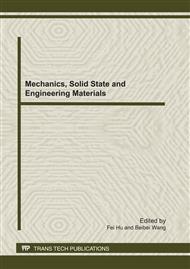p.147
p.151
p.157
p.161
p.166
p.170
p.174
p.181
p.186
Preconcentration and Separation Capabilities of Nano-Barium-Strontium Titanate Powder Coated by Dithizone for Trace Cobalt in Water
Abstract:
A new method for the preconcentration and separation of cobalt ion in water was described. The methodology combines determination using a flame atomic absorption spectrometry (FAAS) with adsorption and desorption of cobalt on the nano-barium-strontium titanate powder coated by dithizone (BST-dithizone). The operation conditions for the pre-concentration and separation of the cobalt, including pH, contact time, eluent condition and co-existing ions have been investigated. The result showed that the cobalt ion could be adsorbed by BST-dithizone. The adsorption quantity was affected by the pH value of medium and shaking time. In the medium of pH 6.0, the adsorption capacity of BST-dithizone to cobalt ion was 8.92 mg·g-1 when the shaking time was more than10 min. The cobalt adsorbed on the adsorbent could be completely eluated and recovered using 10 g·L−1 ethylene diamine tetraacetic acid (EDTA) solution. The enrichment factor was 100. The detection limit of cobalt was 0.53 ng·L−1. The purposed method has been applied to the pre-concentration and separation of cobalt in the water sample with satisfied results.
Info:
Periodical:
Pages:
166-169
Citation:
Online since:
July 2011
Authors:
Keywords:
Price:
Сopyright:
© 2011 Trans Tech Publications Ltd. All Rights Reserved
Share:
Citation:


